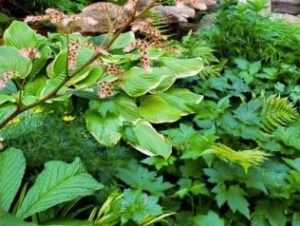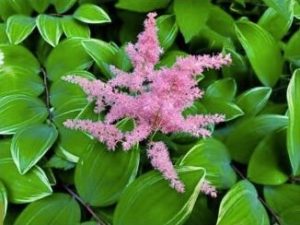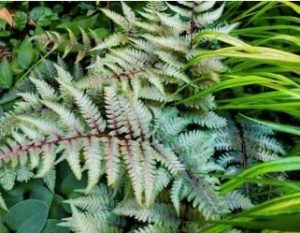This article originally appeared in The Designer, the Journal of the Association for Professional Landscape Designers Spring 2021 Association of Professional Landscape Designers issue and is reprinted with their permission and the authors.
By Shanti Nagel and Meral Marino
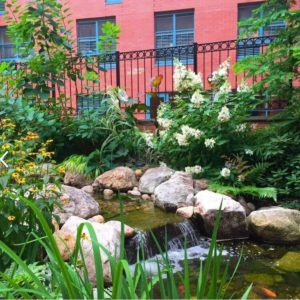 If you pop your head into the courtyard on 53rd street, a lush interior garden shared by 86 units of affordable housing in Midtown Manhattan, you are likely to find Ursula parked in her wheelchair amidst the flowers and sunshine. Ursula was flooded out of her home during Hurricane Sandy and had to relocate to 53rd street. She spends many of her days in the shared garden below her apartment, often with her latest knitting project in her lap or her painting kit. She meets friends for tea or visits with her son when he stops by. We asked her why the garden is so important to her, and she said ‘It is a magic place!’.
If you pop your head into the courtyard on 53rd street, a lush interior garden shared by 86 units of affordable housing in Midtown Manhattan, you are likely to find Ursula parked in her wheelchair amidst the flowers and sunshine. Ursula was flooded out of her home during Hurricane Sandy and had to relocate to 53rd street. She spends many of her days in the shared garden below her apartment, often with her latest knitting project in her lap or her painting kit. She meets friends for tea or visits with her son when he stops by. We asked her why the garden is so important to her, and she said ‘It is a magic place!’.
We have been designing and maintaining horticulturally exceptional and long-lasting gardens for lower income New Yorkers for over a decade. By designing and maintaining dozens of properties over the years we have come to deeply understand the importance of green spaces as a human right and a profoundly needed resource for sanctuary and peace.
The relationship between humans and the natural world is essential for individual health and the strength of communities. We are excited now that science has proven this to be true as we’ve always known. We know that the trees are talking to each other, that they are sharing resources and caring for each other in times of danger. We know that we can learn so much from them! Numerous studies have shown us that the proximity to trees, to gardens and to open space has far reaching and deeply essential benefits to our physical and mental health.
- Rodgersia, Anemone, Hakonechloa, Hosta, Dryopteris Erythrosora ‘Brilliance’
- Polyganatum odoratum virgatum, Astilbe flower
- Hakonechloa, Hosta, Athyrium niponicum
As New York City weather the Covid shutdown last year we saw a glimpse into how privilege and wealth effect our access to gardens and our relationship to land. Many wealthier New Yorkers endured quarantine in homes boasting green space or more often moved out of the city completely to country homes and family properties. While lower income New Yonkers existed between four small walls often without even access to public open space. Can we please take a moment right now to fully understand this great disparity and how drastically different these two realities are? And the very real ramifications this has on people’s lives, health, and futures.
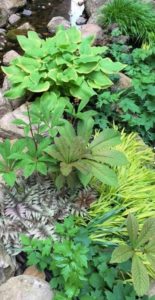
Rodgersia, Anemone, Hakonechloa, Hosta, and Athyrium niponicum
Steven has been a resident of 53rd street for over 10 years. In the past, Steven struggled with substance abuse and lost his apartment. He experienced homelessness and lived in and out of shelters and halfway homes for a time. He told us that his move to 53rd street was ‘life changing’ and that for the past decade he has had a real HOME. If you are looking for Steven, you can often find him sitting under the grove of Dawn Redwoods in the courtyard watching the goldfish swimming in the babbling stream. Steven loves meeting up with his neighbors for a chat in the garden and is known to take a lot of photos of the fish.
In creating these gardens, we use predominately perennial and woody plantings with the goal of long term beautiful for years and year without a ton of intervention and annual additions. We use natives not exclusively but predominantly. Some of our favorite plants in this work include: Cotinus, Ilex glabra, Hydrangea paniculata, Hamamelis, Clethra, Amelanchier, Agastache, Solidago, Asclepias, Anemone and so many more!
About the Authors
Shanti Nagel is a New York-based landscape designer and the principal at Design Wild where she is working to create peace and equity through the magic of plants. As a landscape designer and community builder, Ms. Nagel is committed to the creation of regenerative open space, transformative beauty, and a radical future. She aligns her work with the plant kingdom to heal the human spirit and cultivate resiliency in our communities for our future on earth.
Meral Marino is the director of Horticulture at CHDC a Manhattan-based not-for-profit community-based organization. Born in Istanbul, Meral immigrated to Austria with her family when she was just six years old. She grew up surrounded by nature in the foothills of the Alps and emigrated to NYC in the 1990s. Today Meral cares for dozens of gardens in affordable housing, along the streets of Hell’s Kitchen and 100’s of city street trees. She is always working to connect the community with plants and gardens.

